Fourier Transform#
Teng-Jui Lin
Content adapted from UW AMATH 301, Beginning Scientific Computing. Although not covered in Spring 2020, the topic is presented in previous years: (1) Theory of the Fourier Transform, (2) Discrete Fourier Transform (DFT) and the Fast Fourier Transform (FFT), (3) FFT and image compression.
Theory of Fourier Transform
Discrete Fourier transform
Fast Fourier transform
Power spectral density
Applications of Fourier transform
Noise filtering
Image compression
numpyimplementationFast Fourier transform
numpy.fft.fft()Inverse fast Fourier transform
numpy.fft.ifft()Frequency of fft
numpy.fft.fftfreq()2D fast Fourier transform
numpy.fft.fft2()
Fourier transform and power spectrum#
Discrete Fourier transform#
The discrete Fourier transform (DFT) transforms a data point
where sine waves of different frequencies are added together. The inverse discrete Fourier transform (iDFT) uses
to transform the frequency coefficient back to data point.
For a set of data points
where
and
DFT has an order of
Fast Fourier transform#
Fast Fourier transform (FFT) computes the same thing as the DFT, but it has a more advantageous order of
Suppose we have a sample with
where
and
so that the computation time is cut for those zero entries. The vector is sorted for even and odd entries, and the first matrix reshuffles them back. We can keep decompose the matrix recursively so that
Even if
Implementation and power spectrum#
Here, we use numpy.fft.fft() command to perform FFT.
Problem Statement. Consider a wave function
where
(a) Determine the FFT on the wave function
(b) Plot the power spectral density at the first half of points that is defined as numpy.fft.fftfreq().
import numpy as np
import matplotlib.pyplot as plt
# define time interval
dt = 0.001
t_initial = 0
t_final = 1
t = np.arange(t_initial, t_final+dt/2, dt)
t_len = len(t)
# define wave function and calculate values
omega1 = 50
omega2 = 120
wave_func = lambda t : np.sin(2*np.pi*omega1*t) + np.sin(2*np.pi*omega2*t)
y_original = wave_func(t)
# perform fft, calculate power spectral density and frequency
y_fft = np.fft.fft(y_original)
PSD = (np.abs(y_fft)**2/t_len) # only need the first half, second half has same info
freq = np.fft.fftfreq(t_len, d=dt)
# plot settings
%config InlineBackend.figure_format = 'retina'
%matplotlib inline
plt.rcParams.update({
'font.family': 'Arial', # Times New Roman, Calibri
'font.weight': 'normal',
'mathtext.fontset': 'cm',
'font.size': 18,
'lines.linewidth': 2,
'axes.linewidth': 2,
'axes.spines.top': False,
'axes.spines.right': False,
'axes.titleweight': 'bold',
'axes.titlesize': 18,
'axes.labelweight': 'bold',
'xtick.major.size': 8,
'xtick.major.width': 2,
'ytick.major.size': 8,
'ytick.major.width': 2,
'figure.dpi': 80,
'legend.framealpha': 1,
'legend.edgecolor': 'black',
'legend.fancybox': False,
'legend.fontsize': 14
})
# plot wave function
fig, ax = plt.subplots(figsize=(8, 4))
ax.plot(t, y_original)
ax.set_xlim(t_initial, 0.15)
ax.set_xlabel('$t$')
ax.set_ylabel('$f(t)$')
ax.set_title('Wave function')
Text(0.5, 1.0, 'Wave function')
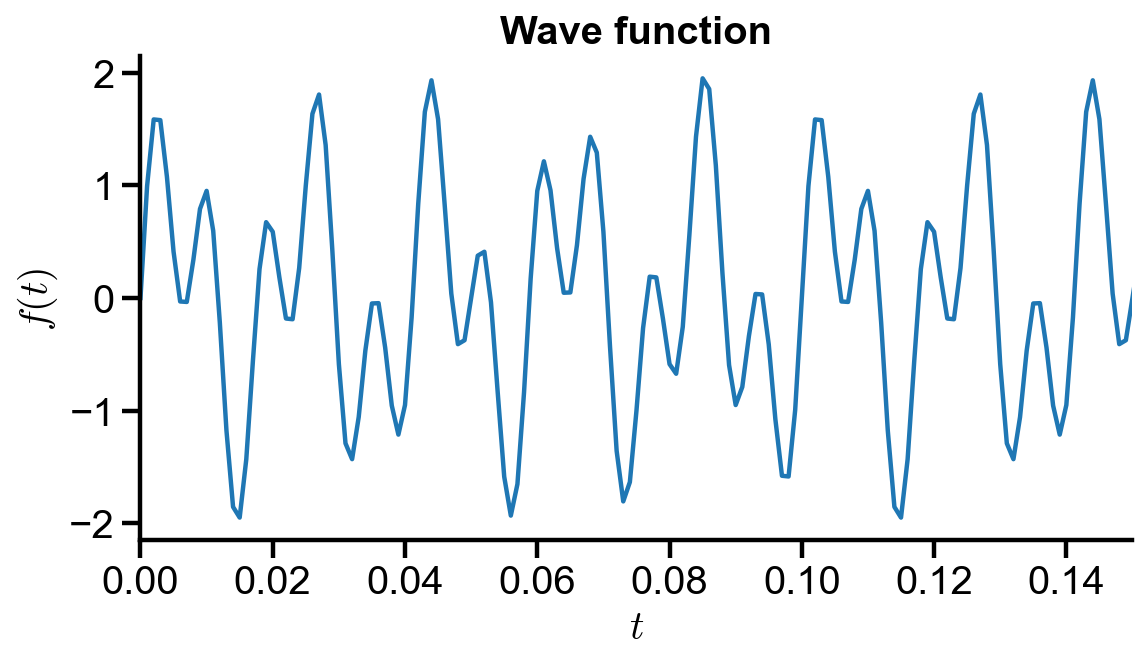
# plot power spectrum
fig, ax = plt.subplots(figsize=(8, 4))
half_t_len = int(np.floor(t_len/2))+1
ax.plot(freq[:half_t_len], PSD[:half_t_len])
ax.set_xlim(0, 200)
ax.set_xlabel('Frequency')
ax.set_ylabel('Power spectral density')
ax.set_title('Power Spectrum')
Text(0.5, 1.0, 'Power Spectrum')
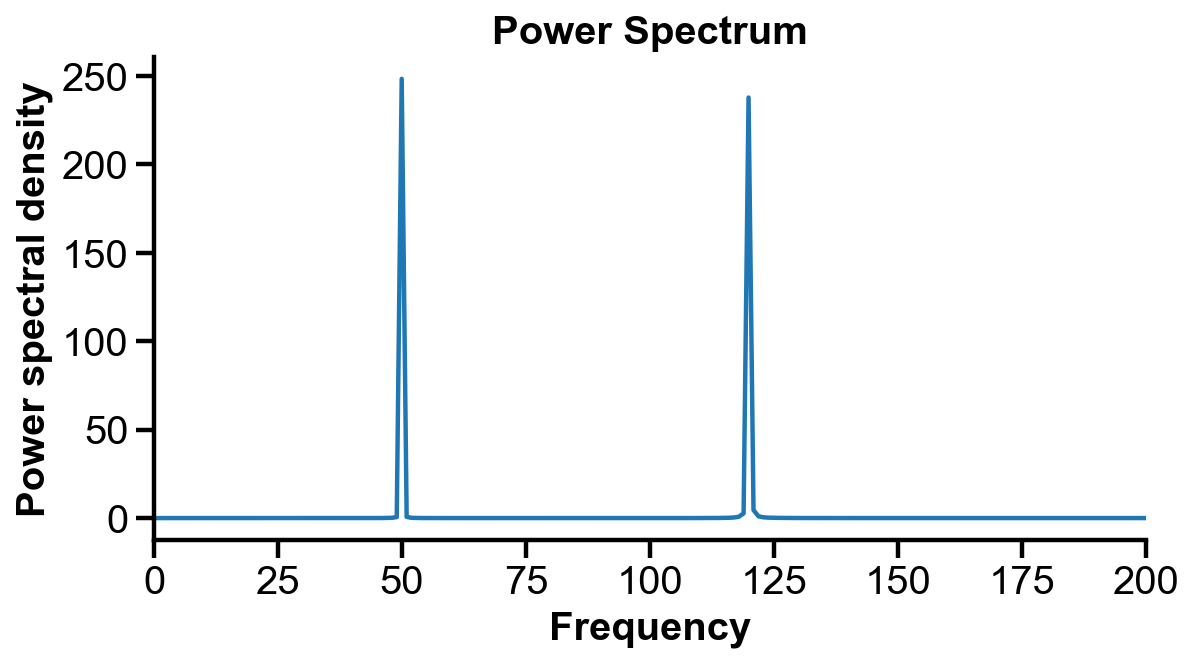
The power spectral density shows peaks at 50 Hz and 120 Hz, which is exactly the frequencies of the wave function.
FFT and noise filtering#
Here, we use numpy.fft.ifft() command to perform iFFT. We use the following process to filter noise:
Problem Statement. Consider a wave function
where
(a) Create a noisy function
(b) Determine the FFT on the wave function
(c) Plot the power spectral density (PSD) of
(d) Use the filter for the PSD to filter
# define time interval
dt = 0.001
t_initial = 0
t_final = 1
t = np.arange(t_initial, t_final+dt/2, dt)
t_len = len(t)
# define wave function and calculate values
omega1 = 70
omega2 = 100
omega3 = 190
wave_func = lambda t : np.sin(2*np.pi*omega1*t) + np.sin(2*np.pi*omega2*t) + np.sin(2*np.pi*omega3*t)
y_original = wave_func(t)
# define noidywave function and calculate values
np.random.seed(1)
wave_func_noisy = lambda t : np.sin(2*np.pi*omega1*t) + np.sin(2*np.pi*omega2*t) + np.sin(2*np.pi*omega3*t) + 2.5*np.random.randn(t_len)
y_noisy = wave_func_noisy(t)
# perform fft, calculate power spectral density and frequency
y_noisy_fft = np.fft.fft(y_noisy)
PSD = (np.abs(y_noisy_fft)**2/t_len)
freq = np.fft.fftfreq(t_len, d=dt)
# threshold power spectral density
threshold = 50
threshold_mask = PSD > threshold
PSD_thresholded = PSD * threshold_mask
# filter fft, then ifft
y_filtered_fft = y_noisy_fft * threshold_mask
y_filtered = np.fft.ifft(y_filtered_fft)
# plot power spectrum
fig, ax = plt.subplots(figsize=(8, 4))
half_t_len = int(np.floor(t_len/2))+1
ax.plot(freq[:half_t_len], PSD[:half_t_len], label='Noisy')
ax.plot(freq[:half_t_len], PSD_thresholded[:half_t_len], label=f'Thresholded ({threshold})')
ax.set_xlim(0, 500)
ax.set_ylim(0)
ax.set_xlabel('Frequency')
ax.set_ylabel('Power spectral density')
ax.set_title('Power Spectrum')
ax.legend()
<matplotlib.legend.Legend at 0x1408e70d2c8>
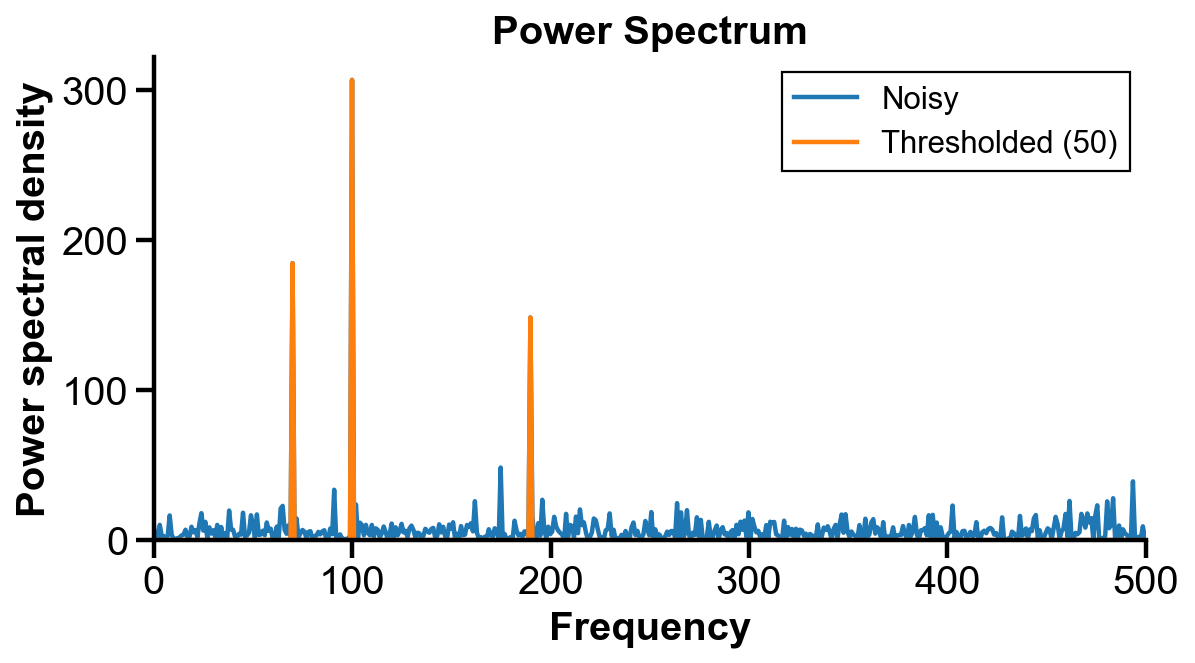
# plot wave function
fig, ax = plt.subplots(figsize=(8, 4))
ax.plot(t, y_original, label='Original')
ax.plot(t, y_noisy, alpha=0.4, label='Noisy')
ax.plot(t, y_filtered, alpha=0.8, label='Filtered')
ax.set_xlim(t_initial, 0.1)
ax.set_ylim(-5, 5)
ax.set_xlabel('$t$')
ax.set_ylabel('$f(t)$')
ax.set_title('Wave function')
ax.legend()
C:\Softwares\Anaconda\Anaconda\lib\site-packages\matplotlib\cbook\__init__.py:1317: ComplexWarning: Casting complex values to real discards the imaginary part
return np.asarray(x, float)
<matplotlib.legend.Legend at 0x1408eeb7108>

FFT and image compression#
Problem Statement. Import the given image dog.jpg.
(a) Using numpy.fft.fft2(), FFT the image and plot the coefficient space.
(b) Threshold the FFT and transform back using iFFT. Compute the compression rate and plot with the image.
(c) Compare different compression rates with the original image.
(d) Compare the original and compressed image in a 3D intensity plot.
Import image#
import skimage
from skimage import io
img = io.imread('dog.jpg')
gray_img = skimage.color.rgb2gray(img)
gray_img.shape
(327, 327)
# plot original img
fig, ax = plt.subplots(figsize=(4, 4))
ax.imshow(gray_img, cmap='gray')
ax.set_title('Gray scale image')
ax.axis('off')
(-0.5, 326.5, 326.5, -0.5)
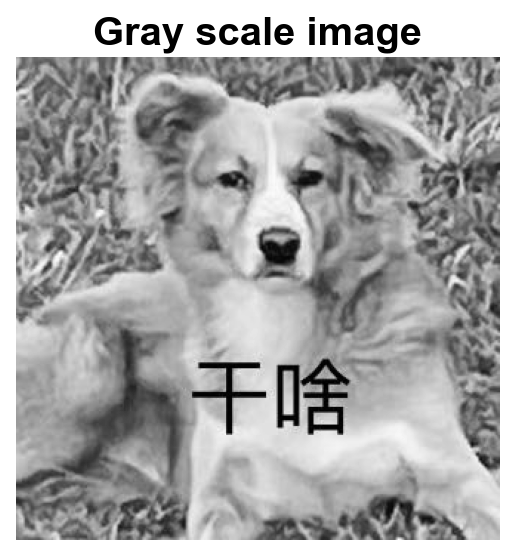
Coefficient space and compression#
# fft and coeff space
gray_img_fft = np.fft.fft2(gray_img)
coeff_space = np.log(abs(np.fft.fftshift(gray_img_fft))+1)
# plot coeff space
fig, ax = plt.subplots(figsize=(4, 4))
ax.imshow(coeff_space, cmap='gray')
ax.set_title('FFT2 of gray scale image')
ax.axis('off')
(-0.5, 326.5, 326.5, -0.5)

# threshold and ifft
threshold = 1e-5 * 100
threshold_mask = abs(gray_img_fft) > threshold*np.max(abs(gray_img_fft))
gray_img_thr_fft = gray_img_fft * threshold_mask
gray_img_thr = abs(np.fft.ifft2(gray_img_thr_fft))
compression_rate = np.sum(threshold_mask) / (np.prod(gray_img.shape))
# plot compressed img
fig, ax = plt.subplots(figsize=(4, 4))
ax.imshow(gray_img_thr, cmap='gray')
ax.set_title(f'Compressed ({compression_rate*100 :.1f}%)')
ax.axis('off')
(-0.5, 326.5, 326.5, -0.5)
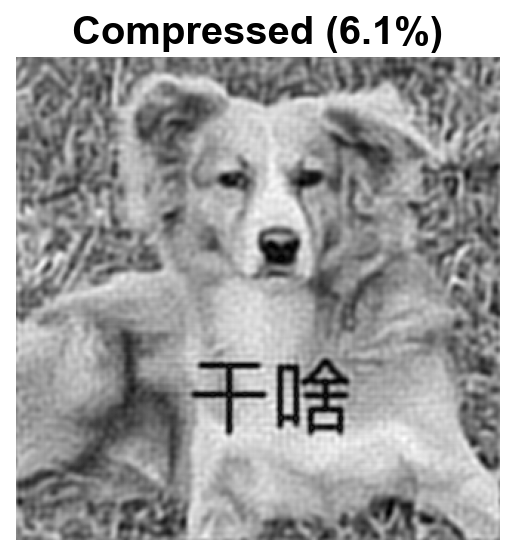
Comparing compression results#
# plot comparison between threshold and original
row = 3
col = 3
thresholds = 1e-5 * np.array([1, 10, 100, 200, 500, 800, 1000])
# calculate and plot compressed img
fig, axs = plt.subplots(row, col, figsize=(9, 9))
for row_i in range(row):
for col_i in range(col):
i = row_i*col+ col_i
threshold_mask = abs(gray_img_fft) > thresholds[i]*np.max(abs(gray_img_fft))
gray_img_thr_fft = gray_img_fft * threshold_mask
gray_img_thr = abs(np.fft.ifft2(gray_img_thr_fft))
compression_rate = np.sum(threshold_mask) / (np.prod(gray_img.shape))
axs[row_i, col_i].imshow(gray_img_thr, cmap='gray')
axs[row_i, col_i].set_title(f'Compressed ({compression_rate*100 :.1f}%)')
axs[row_i, col_i].axis('off')
if i == (len(thresholds)-1):
break
if i == (len(thresholds)-1):
break
# plot original img and coeff space
axs[2, 1].imshow(gray_img, cmap='gray')
axs[2, 1].set_title('Original')
axs[2, 1].axis('off')
axs[2, 2].imshow(coeff_space, cmap='gray')
axs[2, 2].set_title('Coefficient space')
axs[2, 2].axis('off')
plt.tight_layout()
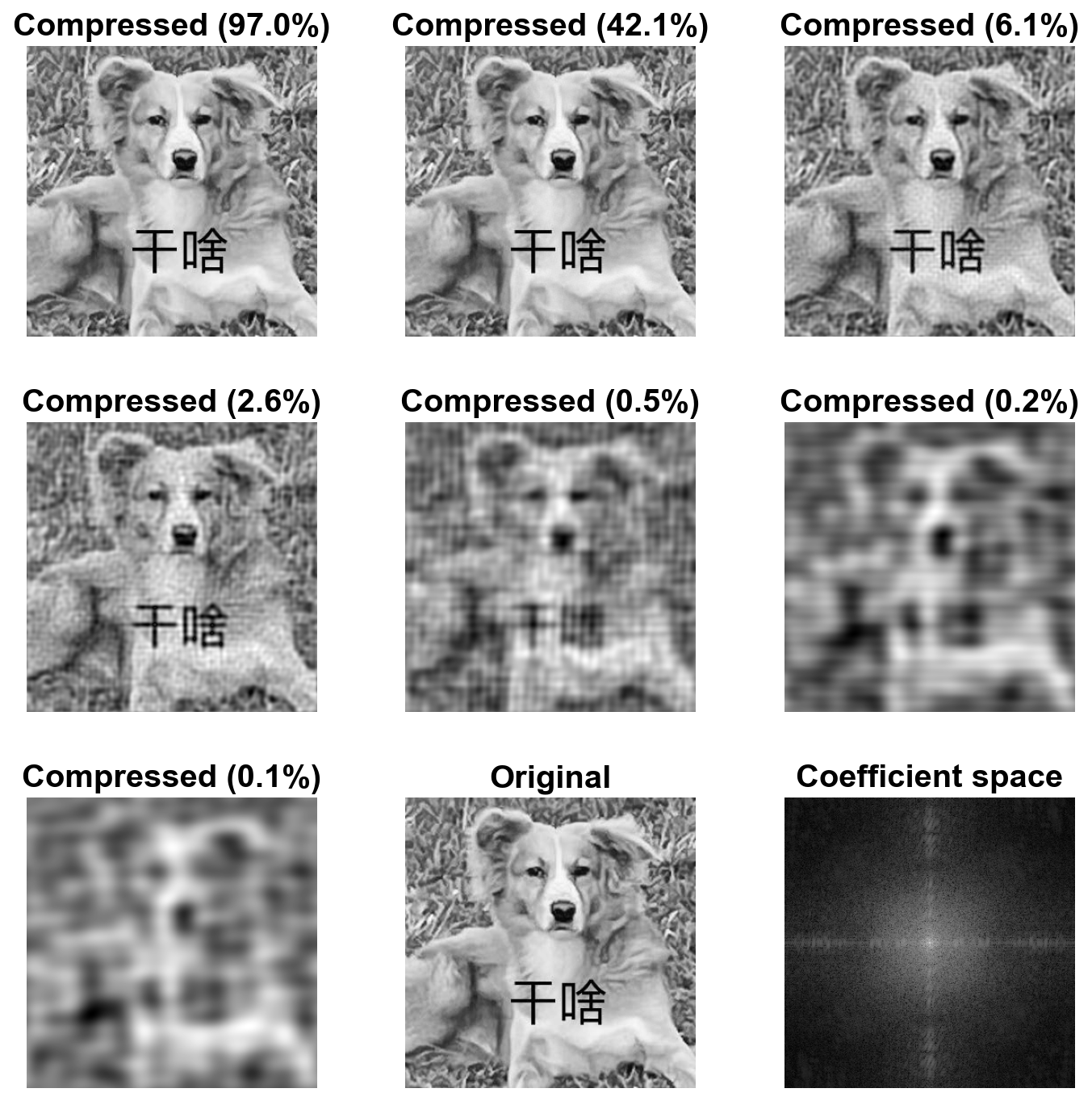
3D intensity plot#
from mpl_toolkits.mplot3d import Axes3D
# plot 3d intensity plot
plt.rcParams.update({'xtick.labelsize': 18,})
fig, axs = plt.subplots(1, 2, figsize=(9, 4), subplot_kw={"projection": "3d"})
XX, YY = np.meshgrid(np.arange(gray_img.shape[0]), np.arange(gray_img.shape[1]))
axs[0].plot_surface(XX, YY, gray_img, cmap='gray')
axs[0].set_title('Original')
axs[0].view_init(45, 45)
axs[0].dist = 12 # zoom out to fit all labels in
axs[1].plot_surface(XX, YY, gray_img_thr, cmap='gray')
axs[1].set_title(f'Compressed ({compression_rate*100 :.1f}%)')
axs[1].view_init(45, 45)
axs[1].dist = 12 # zoom out to fit all labels in
plt.tight_layout()
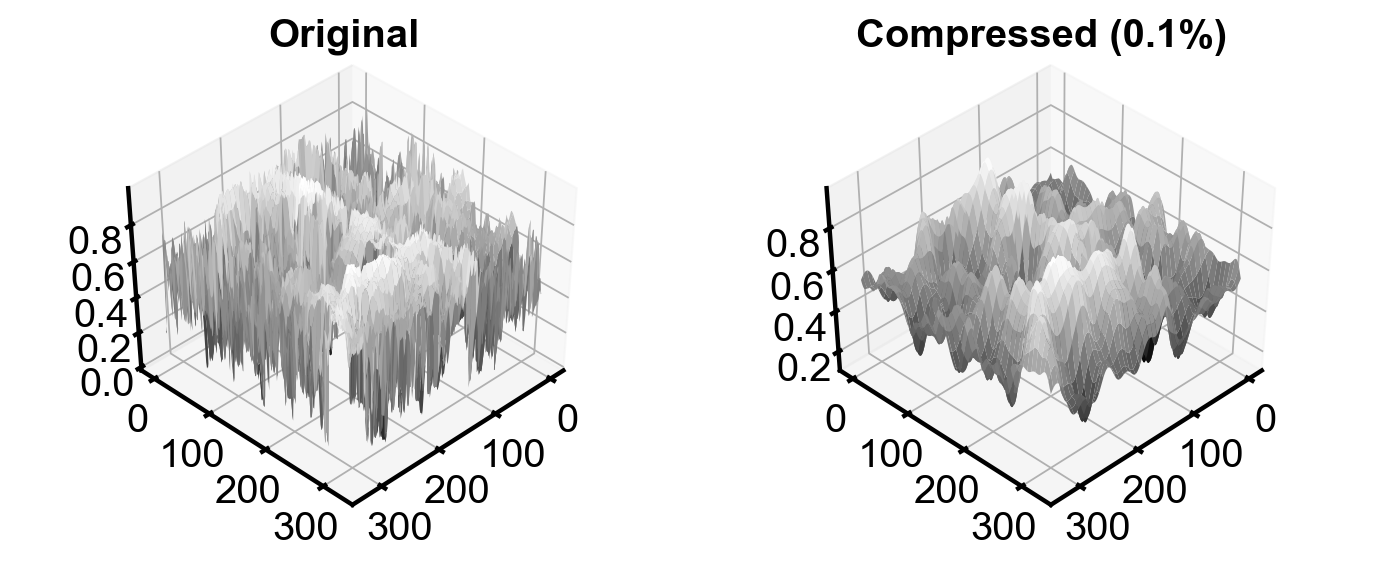
The compressed image smoothens the peaks in the original image.

